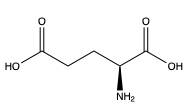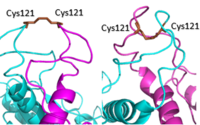Sandbox Reserved 1715
From Proteopedia
(Difference between revisions)
| Line 47: | Line 47: | ||
'''3.''' A second glutamate binds to the other <scene name='90/904320/Active_site_interactions/3'>binding pocket</scene> of the VFT. Mediated by L639, F643, N735, W773, and F776, a <scene name='90/904320/Pam/5'>positive allosteric modulator</scene> (PAM) also binds within the seven TMD helices of the alpha chain <ref name="Seven">PMID:34194039</ref>. This closed conformation with an inter-lobe domain of 25 degrees is considered the active conformation<ref name="Seven">PMID:34194039</ref>. The binding of these ligands allows the CRD to compact and come together. This transformation causes the TMD to form another asymmetric conformation with a TM6-TM6 interface between the chains<ref name="Seven">PMID:34194039</ref>.[[Image: Protein Interaction with G Protein.png|200 px|right|thumb|Figure 4. The interaction between an active mGlu and a G-protein ]] | '''3.''' A second glutamate binds to the other <scene name='90/904320/Active_site_interactions/3'>binding pocket</scene> of the VFT. Mediated by L639, F643, N735, W773, and F776, a <scene name='90/904320/Pam/5'>positive allosteric modulator</scene> (PAM) also binds within the seven TMD helices of the alpha chain <ref name="Seven">PMID:34194039</ref>. This closed conformation with an inter-lobe domain of 25 degrees is considered the active conformation<ref name="Seven">PMID:34194039</ref>. The binding of these ligands allows the CRD to compact and come together. This transformation causes the TMD to form another asymmetric conformation with a TM6-TM6 interface between the chains<ref name="Seven">PMID:34194039</ref>.[[Image: Protein Interaction with G Protein.png|200 px|right|thumb|Figure 4. The interaction between an active mGlu and a G-protein ]] | ||
| - | '''4.''' The <scene name='90/904320/Active_helices/ | + | '''4.''' The <scene name='90/904320/Active_helices/2'>crossover of the helices</scene> from the alpha and beta chains allows for intracellular loop 2 (ICL2) and the C-terminus to be properly ordered to interact with a G protein<ref name="Seven">PMID:34194039</ref>. While hydrogen bonding is present, this coupling is primarily driven by the hydrophobic interactions in the interface with the ɑ5 helix of the G protein <ref name="Seven">PMID:34194039</ref>(Figure 4). This <scene name='90/904320/Active_mglu/4'>mGlu/G-protein coupling</scene> can only occur in the presence of a PAM as the pocket in which the coupling occurs would be completely closed in its absence<ref name="Seven">PMID:34194039</ref>. |
'''5.''' Depending on the type of mGlu present, different signaling cascades will occur within the cell <ref name="Lin">PMID:34135510</ref>. These cascades are necessary for cellular function and can lead to various diseases<ref name="Crupi">PMID:30800054</ref>. | '''5.''' Depending on the type of mGlu present, different signaling cascades will occur within the cell <ref name="Lin">PMID:34135510</ref>. These cascades are necessary for cellular function and can lead to various diseases<ref name="Crupi">PMID:30800054</ref>. | ||
Revision as of 19:23, 29 March 2022
| |||||||||||
3D Structures
7mtr, mGlu Active
7epa, MGlu Inactive
References
- ↑ Niswender CM, Conn PJ. Metabotropic glutamate receptors: physiology, pharmacology, and disease. Annu Rev Pharmacol Toxicol. 2010;50:295-322. doi:, 10.1146/annurev.pharmtox.011008.145533. PMID:20055706 doi:http://dx.doi.org/10.1146/annurev.pharmtox.011008.145533
- ↑ 2.00 2.01 2.02 2.03 2.04 2.05 2.06 2.07 2.08 2.09 2.10 2.11 2.12 2.13 Seven AB, Barros-Alvarez X, de Lapeyriere M, Papasergi-Scott MM, Robertson MJ, Zhang C, Nwokonko RM, Gao Y, Meyerowitz JG, Rocher JP, Schelshorn D, Kobilka BK, Mathiesen JM, Skiniotis G. G-protein activation by a metabotropic glutamate receptor. Nature. 2021 Jun 30. pii: 10.1038/s41586-021-03680-3. doi:, 10.1038/s41586-021-03680-3. PMID:34194039 doi:http://dx.doi.org/10.1038/s41586-021-03680-3
- ↑ 3.0 3.1 3.2 3.3 Lin S, Han S, Cai X, Tan Q, Zhou K, Wang D, Wang X, Du J, Yi C, Chu X, Dai A, Zhou Y, Chen Y, Zhou Y, Liu H, Liu J, Yang D, Wang MW, Zhao Q, Wu B. Structures of Gi-bound metabotropic glutamate receptors mGlu2 and mGlu4. Nature. 2021 Jun;594(7864):583-588. doi: 10.1038/s41586-021-03495-2. Epub 2021, Jun 16. PMID:34135510 doi:http://dx.doi.org/10.1038/s41586-021-03495-2
- ↑ 4.0 4.1 4.2 4.3 4.4 Crupi R, Impellizzeri D, Cuzzocrea S. Role of Metabotropic Glutamate Receptors in Neurological Disorders. Front Mol Neurosci. 2019 Feb 8;12:20. doi: 10.3389/fnmol.2019.00020. eCollection , 2019. PMID:30800054 doi:http://dx.doi.org/10.3389/fnmol.2019.00020
- ↑ Bordi F, Ugolini A. Group I metabotropic glutamate receptors: implications for brain diseases. Prog Neurobiol. 1999 Sep;59(1):55-79. doi: 10.1016/s0301-0082(98)00095-1. PMID:10416961 doi:http://dx.doi.org/10.1016/s0301-0082(98)00095-1
- ↑ Conn PJ, Lindsley CW, Jones CK. Activation of metabotropic glutamate receptors as a novel approach for the treatment of schizophrenia. Trends Pharmacol Sci. 2009 Jan;30(1):25-31. doi: 10.1016/j.tips.2008.10.006. Epub, 2008 Dec 6. PMID:19058862 doi:http://dx.doi.org/10.1016/j.tips.2008.10.006
Student Contributors
- Courtney Vennekotter
- Cade Chezem




